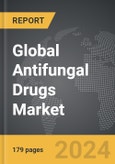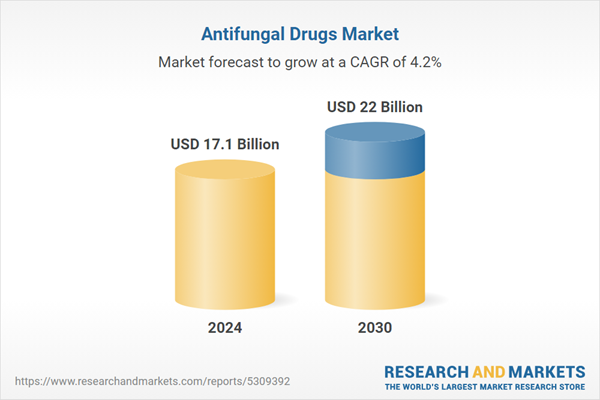Global Antifungal Drugs Market - Key Trends and Drivers Summarized
Why Are Antifungal Drugs Crucial in Modern Medicine?
Antifungal drugs are essential in modern medicine due to their role in combating fungal infections, which can range from superficial skin conditions to severe systemic infections. These infections are caused by fungi such as yeasts, molds, and dermatophytes, which can affect various parts of the body including the skin, nails, lungs, and bloodstream. Superficial infections like athlete's foot and ringworm are common and easily treatable with topical antifungal creams. However, systemic infections, such as those caused by Candida or Aspergillus species, can be life-threatening, especially in immunocompromised individuals. These patients include those undergoing chemotherapy, organ transplant recipients, and individuals with HIV/AIDS. Therefore, antifungal drugs are vital in both treating common fungal infections and preventing severe complications in vulnerable populations.What Are the Major Classes of Antifungal Drugs and Their Mechanisms?
The major classes of antifungal drugs include azoles, polyenes, echinocandins, and allylamines, each with distinct mechanisms of action. Azoles, such as fluconazole and itraconazole, inhibit the synthesis of ergosterol, an essential component of fungal cell membranes. Polyenes, including amphotericin B and nystatin, bind to ergosterol, creating pores in the fungal cell membrane, leading to cell death. Echinocandins, such as caspofungin, inhibit the synthesis of β-glucan, a critical component of the fungal cell wall, thereby disrupting cell wall integrity and causing cell lysis. Allylamines, like terbinafine, inhibit squalene epoxidase, another enzyme involved in ergosterol synthesis, resulting in toxic accumulation of squalene and cell death. These different mechanisms allow for targeted treatment based on the type and severity of the fungal infection, improving patient outcomes.How Are Technological Advancements Influencing Antifungal Drug Development?
Technological advancements are significantly influencing the development of antifungal drugs, leading to improved efficacy and reduced side effects. Innovations in drug delivery systems, such as liposomal formulations and nanoparticle carriers, enhance the bioavailability and targeted delivery of antifungal agents, minimizing toxicity and improving patient compliance. Advances in genomics and molecular biology are facilitating the identification of new drug targets and the development of novel antifungal agents with unique mechanisms of action. High-throughput screening and computational drug design are accelerating the discovery and optimization of potent antifungal compounds. Furthermore, the development of combination therapies, where multiple antifungal agents are used together, is proving effective in overcoming resistance and improving treatment outcomes. These technological advancements are crucial in addressing the challenges of antifungal resistance and expanding the arsenal of effective treatments against fungal infections.What Factors Are Driving Growth in the Antifungal Drugs Market?
The growth in the antifungal drugs market is driven by several factors related to technological advancements, increasing prevalence of fungal infections, and evolving healthcare needs. The rising incidence of fungal infections, particularly among immunocompromised individuals and the elderly, is a major driver. Advances in antifungal drug formulations and delivery systems are enhancing treatment efficacy and patient adherence, contributing to market growth. The expanding use of broad-spectrum antifungal agents and the development of novel drugs targeting resistant strains are also propelling the market. Additionally, increasing awareness of fungal infections and improved diagnostic techniques are leading to earlier and more accurate diagnosis, driving demand for effective treatments. The integration of antifungal drugs in comprehensive care plans for chronic diseases and the rising trend of prophylactic antifungal use in high-risk populations are further supporting market expansion. These factors collectively contribute to a robust and dynamic market landscape for antifungal drugs.Report Scope
The report analyzes the Antifungal Drugs market, presented in terms of market value (USD). The analysis covers the key segments and geographic regions outlined below.- Segments: Drug Class (Azoles, Echinocandins, Polyenes, Allylamines, Other Drug Classes); Indication (Candidiasis, Aspergillosis, Dermatophytosis, Other Indications).
- Geographic Regions/Countries: World; United States; Canada; Japan; China; Europe (France; Germany; Italy; United Kingdom; Spain; Russia; and Rest of Europe); Asia-Pacific (Australia; India; South Korea; and Rest of Asia-Pacific); Latin America (Argentina; Brazil; Mexico; and Rest of Latin America); Middle East (Iran; Israel; Saudi Arabia; United Arab Emirates; and Rest of Middle East); and Africa.
Key Insights:
- Market Growth: Understand the significant growth trajectory of the Azoles segment, which is expected to reach US$10.7 Billion by 2030 with a CAGR of 4.5%. The Echinocandins segment is also set to grow at 3.9% CAGR over the analysis period.
- Regional Analysis: Gain insights into the U.S. market, valued at $4.5 Billion in 2024, and China, forecasted to grow at an impressive 6.6% CAGR to reach $4.7 Billion by 2030. Discover growth trends in other key regions, including Japan, Canada, Germany, and the Asia-Pacific.
Why You Should Buy This Report:
- Detailed Market Analysis: Access a thorough analysis of the Global Antifungal Drugs Market, covering all major geographic regions and market segments.
- Competitive Insights: Get an overview of the competitive landscape, including the market presence of major players across different geographies.
- Future Trends and Drivers: Understand the key trends and drivers shaping the future of the Global Antifungal Drugs Market.
- Actionable Insights: Benefit from actionable insights that can help you identify new revenue opportunities and make strategic business decisions.
Key Questions Answered:
- How is the Global Antifungal Drugs Market expected to evolve by 2030?
- What are the main drivers and restraints affecting the market?
- Which market segments will grow the most over the forecast period?
- How will market shares for different regions and segments change by 2030?
- Who are the leading players in the market, and what are their prospects?
Report Features:
- Comprehensive Market Data: Independent analysis of annual sales and market forecasts in US$ Million from 2024 to 2030.
- In-Depth Regional Analysis: Detailed insights into key markets, including the U.S., China, Japan, Canada, Europe, Asia-Pacific, Latin America, Middle East, and Africa.
- Company Profiles: Coverage of players such as Abbott Laboratories, Inc., Bayer AG, Enzon Pharmaceuticals, Inc., Gilead Sciences, Inc., GlaxoSmithKline PLC and more.
- Complimentary Updates: Receive free report updates for one year to keep you informed of the latest market developments.
Some of the 11 companies featured in this Antifungal Drugs market report include:
- Abbott Laboratories, Inc.
- Bayer AG
- Enzon Pharmaceuticals, Inc.
- Gilead Sciences, Inc.
- GlaxoSmithKline PLC
- Merck & Co., Inc.
- Novartis International AG
- Pfizer, Inc.
- Sanofi SA
- SCYNEXIS, Inc.
This edition integrates the latest global trade and economic shifts into comprehensive market analysis. Key updates include:
- Tariff and Trade Impact: Insights into global tariff negotiations across 180+ countries, with analysis of supply chain turbulence, sourcing disruptions, and geographic realignment. Special focus on 2025 as a pivotal year for trade tensions, including updated perspectives on the Trump-era tariffs.
- Adjusted Forecasts and Analytics: Revised global and regional market forecasts through 2030, incorporating tariff effects, economic uncertainty, and structural changes in globalization. Includes historical analysis from 2015 to 2023.
- Strategic Market Dynamics: Evaluation of revised market prospects, regional outlooks, and key economic indicators such as population and urbanization trends.
- Innovation & Technology Trends: Latest developments in product and process innovation, emerging technologies, and key industry drivers shaping the competitive landscape.
- Competitive Intelligence: Updated global market share estimates for 2025, competitive positioning of major players (Strong/Active/Niche/Trivial), and refined focus on leading global brands and core players.
- Expert Insight & Commentary: Strategic analysis from economists, trade experts, and domain specialists to contextualize market shifts and identify emerging opportunities.
Table of Contents
Companies Mentioned (Partial List)
A selection of companies mentioned in this report includes, but is not limited to:
- Abbott Laboratories, Inc.
- Bayer AG
- Enzon Pharmaceuticals, Inc.
- Gilead Sciences, Inc.
- GlaxoSmithKline PLC
- Merck & Co., Inc.
- Novartis International AG
- Pfizer, Inc.
- Sanofi SA
- SCYNEXIS, Inc.
Table Information
| Report Attribute | Details |
|---|---|
| No. of Pages | 179 |
| Published | October 2025 |
| Forecast Period | 2024 - 2030 |
| Estimated Market Value ( USD | $ 17.1 Billion |
| Forecasted Market Value ( USD | $ 22 Billion |
| Compound Annual Growth Rate | 4.2% |
| Regions Covered | Global |









